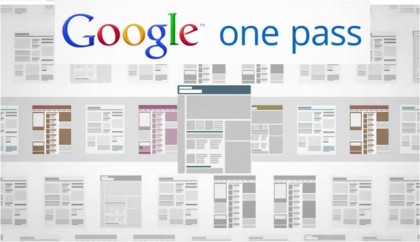
The slings and arrows are flying fast and furious. On the heels of Apple’s announcement yesterday of a new in-app subscription option for digital publishers, Google has news out today detailing its rival offering, the Google One Pass System. Google’s subscription plan is far kinder to publishers. As Dave noted, Apple takes a 30% cut of revenue, and more importantly, doesn’t allow publishers to link to their own sites for content purchases, or offer prices anywhere that undercut Apple iTunes listings. Google, on the other hand, says One Pass is a payment authentication system that lets publishers sell subscriptions in a more flexible manner. Content owners can price subscriptions however they like, promoting and selling content with a single payment system, from multiple locations, and without restriction. Here’s the little dig at Apple from Google’s description of One Pass on its site.
Google One Pass operates across multiple sites, so you can easily manage content across all of your online properties. It also offers payments in mobile apps, in instances where the mobile OS terms permit transactions to take place outside of the app market.
It occurs to me that the digital publishing field is about to go through its own version of the TV retransmission wars. However, the positions of power may be reversed. In television, the content owners are clamoring for more money from the distributors (cable, telco, and satellite providers). In the new publishing model, Apple – a distributor – is demanding harsh payment terms from the content owners.
Apple may be taking an aggressive stance now because it knows it will have to compromise in the future. The Huffington Post reports that Google’s revenue cut with each transaction – including in-app subscriptions – is 10% or less compared to Apple’s 30% deal. That suggests that Apple may not be able to hold on to its position of power for long. Competition is a mighty force, and in the end, content is always king.
Google has a much smaller install base, so they can’t afford to scare off content owners with a 30% cut.
With over 100 million iOS devices out there, Apple has a very large customer base. They can almost do whatever they want, barring legal action (which I’m sure will come).
Note that Apple’s new business model actual affects Google since Google has a Google Book reader. If Google doesn’t pull that app, Google have to pay 30% of their Google Book sales (made in app) to Apple. Apple doesn’t write apps for Android so the reverse is not true.
Apparently that number is now over 160 million iOS device users. It grew 60 million it the last 6 months.
http://www.apple.com/pr/library/2011/01/22appstore.html
Feels like me like this is usurious. 30% on apps, something that didn’t exist before? Okay maybe. Volumes have gone through the roof, so developers benefited from the deal. On digital magazine subscriptions, is Apple’s ecosystem as important? Seems to me that most often you’d know about the magazine or newspaper before you looked in iTunes to see if it was there. Plus I just can’t imagine the profits in publishing are sufficient to justify a 30% cut.
Since Apple has clarified that the rules apply to Amazon’s Kindle application as well, I’m assuming they are simply forcing the Kindle application off iOS. And I’ll be fine with that, probably just buy a Kindle instead and read less on the iPad, which will now be less valuable to me. Amazon likely doesn’t make 30% profit on its ebook sales, and since they’re not allowed to sell those ebooks for less elsewhere, they’re being put between a rock and a hard place. I presume they’ll pull out. As will Barnes and Noble, Zinio and others.
Unless they’re going to allow people to twist out of this by creating slightly different products for iOS so the lowest price requirement doesn’t apply. But I can’t imagine they’ll allow that…
Glenn, if Apple doesn’t work out a compromise what we’re going to see is a web-based Kindle reader and Slacker player…
@Dave,
Yeah that’s better than nothing, but will it work on an airplane or if I don’t have an internet connection? I know in theory that HTML 5 is supposed to support local storage etc, but does it actually work right now?
Morac – Figures released in January show Apple, RIM, an Android neck-in-neck with regard to the US installed base of smartphones. In the US at least Android has about the same number of users as iOS – and Android is selling at a higher rate than iOS, so the Android installed base should pass iOS and continue to expand the gap.
Worldwide Android was rapidly catching up to iOS in installed base, and had the same higher growth, so it should eventually catch up and then surpass iOS as well. Likely this year – Android is growing faster than expected, it wasn’t initially expected to reach parity with iOS in 2010 – thoughts were late 2011 into 2012 – but it did.
While iPod Touches and iPads add to Apple’s numbers, the real significant numbers are in phone sales. Apple needs to be careful about abusing their position with a strong, viable alternative on the market. Android is rapidly improving, as is the HW from the various vendors. And there are a number of Android Honeycomb tablets about to hit which out-spec the iPad by a wide margin, likely giving any iPad 2 a good run for the money too.
Apple had a de facto monopoly for a while, but they’re not the only game in town now.
We’ll see how this breaks, but so far it seems as if different publishers are aligning themselves with different ecosystems. Want a Time Subscription? Buy an HP Touchpad. Want “The Daily”? Get an iPad. That situation can’t be good for anyone.